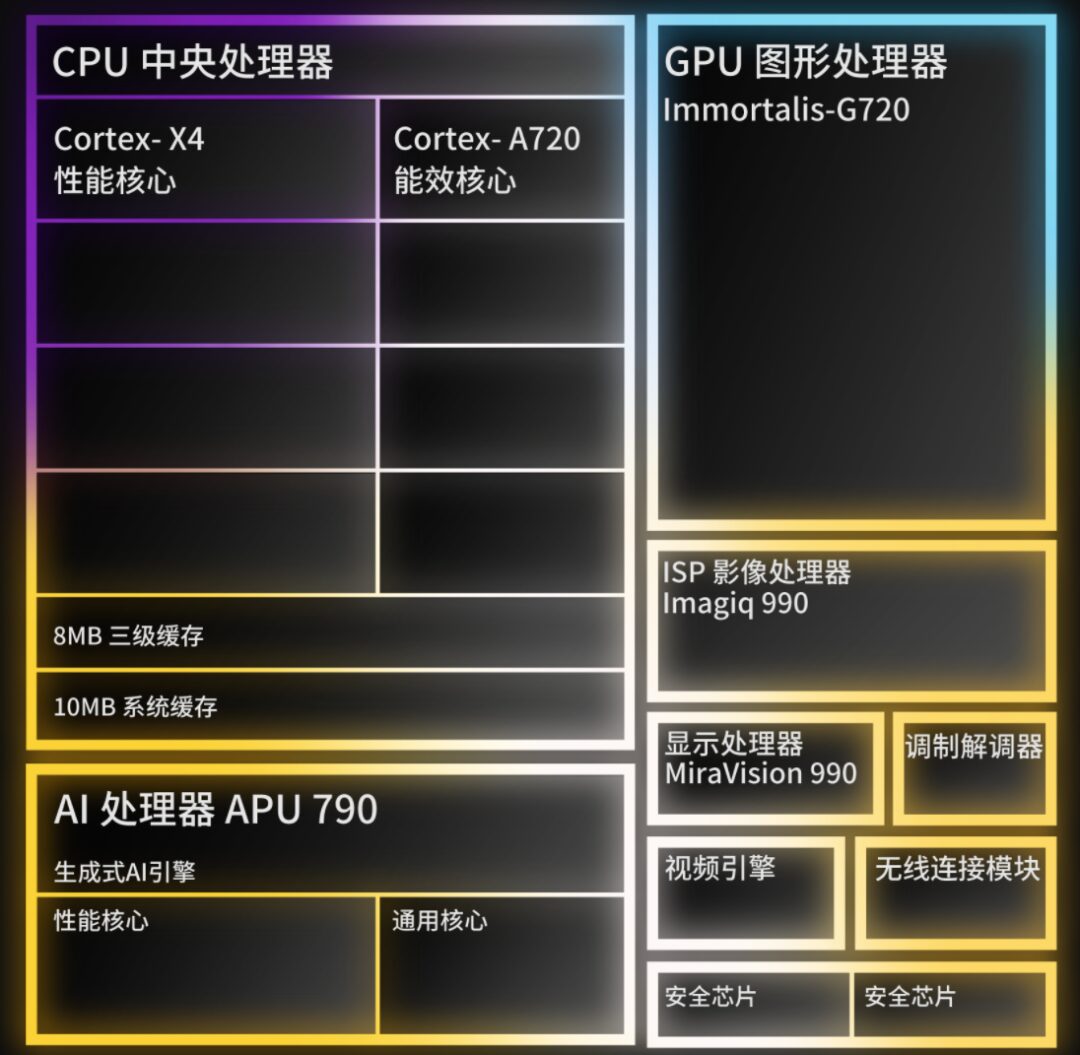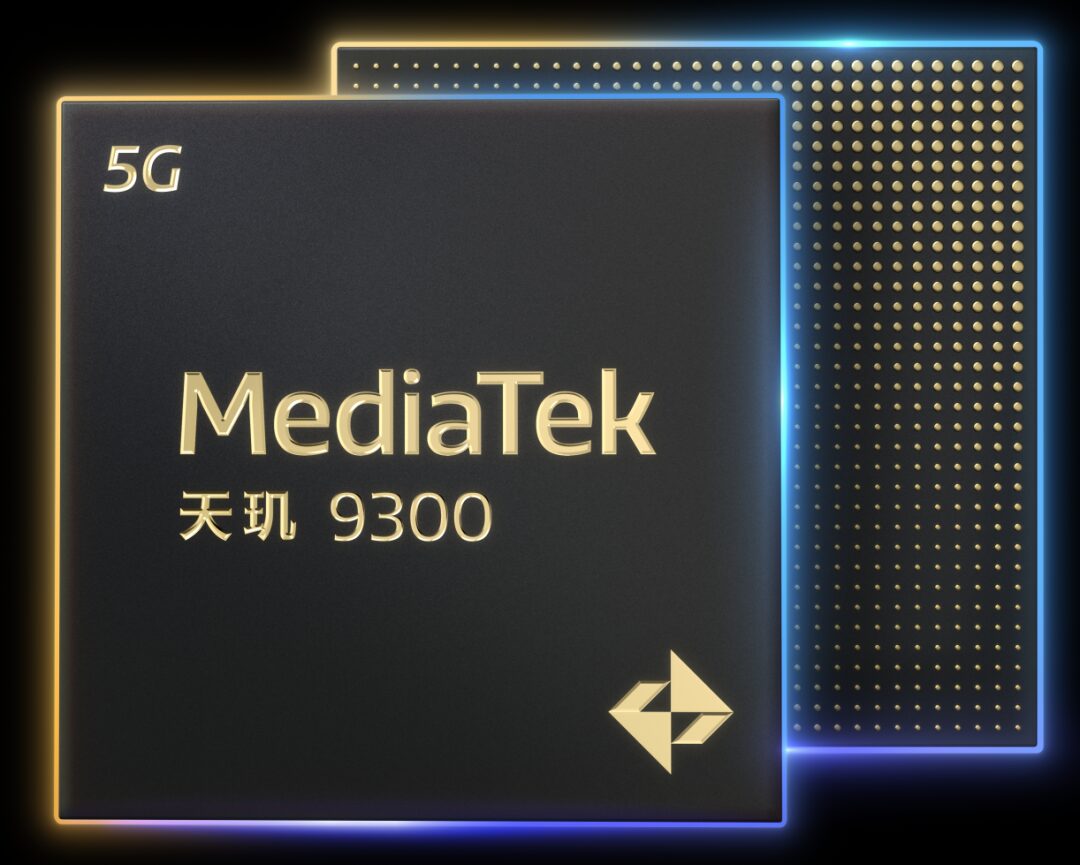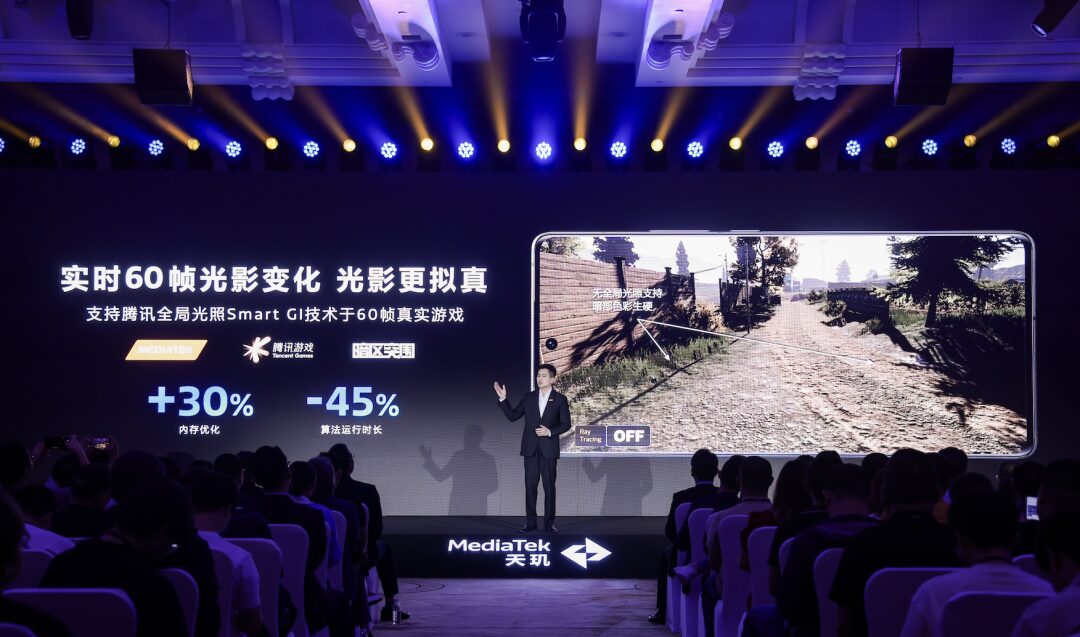Smartphone mobile SoC flagship platform design company, emerging as a dark horse, shocks the industry.
On November 6, MediaTek launched the industry’s first flagship mobile platform “Dimensity 9300” with an all big-core architecture SoC. This flagship chip refreshes industry perception with its unprecedented “4 (ultra-performance cores) + 4 (large efficiency cores)” CPU architecture. At the same time, this is also MediaTek’s first flagship 5G generative AI mobile chip.

Thanks to this architectural innovation, the CPU peak performance of Dimensity 9300 has increased by as much as 40% compared to its predecessor. At the same time, MediaTek’s principle of “not sacrificing low power consumption for high performance” has also been reflected in this generation of SoC: power savings have reached an astonishing 33%.
With such outstanding performance improvement and power consumption control, the most significant application change is the excellent experience brought by Dimensity 9300’s ultra-low-latency edge AI large model terminal.
This experience comes from the multiple technological firsts established by the strongest flagship SoC mobile platform just released by MediaTek: this is the industry’s first integrated hardware generative AI engine, the first to provide edge LORA fusion acceleration technology, the first to provide hardware memory compression technology, supporting edge AI large models with 1 billion, 7 billion, 13 billion, and up to 33 billion parameters…
From Dimensity 9000 to the 2022 Dimensity 9200, and now to the Dimensity 9300, MediaTek has frequently highlighted its technological innovations, moving faster than its competitors Apple and Qualcomm.
Regarding the newly launched all big-core architecture design, Zhang Genghao, product planning director of MediaTek’s wireless communication division, confidently believes, “Starting this year, all big-core may become a new standard specification, ushering in an era of all big-core in the future.”

Super Performance Energy Comes from Architectural Design Innovation
Dimensity 9300 adopts TSMC’s third-generation 4nm process, just like Qualcomm’s Snapdragon 8 Gen 3.

Compared to its predecessor Dimensity 9200, this generation’s CPU performance has increased by as much as 40%, while GPU performance has exceeded 40% to reach 46%; the energy consumption control levels for both have improved by 33% and 45%, respectively.
How impressive is this performance?
According to the Geekbench 6.2 testing platform, Dimensity 9300 scored 2215 in single-core performance, while multi-core performance soared to 7733, surpassing all similar flagship models in the industry.
This performance even exceeds the realm of Moore’s Law—Apple’s A17 Pro, which uses TSMC’s 3nm process (claimed to be the strongest mobile SoC on the planet), scored 7342 in multi-core performance (with a single-core score of 2955); Qualcomm’s newly released Snapdragon 8 Gen 3 scored 7114 in multi-core performance (with a single-core score of 2187).
This formidable CPU performance is attributed to the all big-core architecture design, which MediaTek has introduced for the first time in the industry.
MediaTek has abandoned the previous big.LITTLE architecture design model used in the flagship Android camp, opting for a new “4 (ultra-big cores) + 4 (big cores)” CPU architecture, shocking the industry.
“Dimensity 9300 is MediaTek’s most powerful flagship mobile chip to date. Through our pioneering all big-core architecture design, it brings astonishing computational breakthroughs to flagship smartphones,” said Dr. Xu Jingquan, Senior Vice President and General Manager of the Wireless Communication Division at MediaTek. “The all big-core CPU combined with the new generation APU, GPU, ISP, and MediaTek’s unique cutting-edge technology not only significantly enhances terminal performance and efficiency but also provides consumers with an exceptional edge generative AI experience.”
Before this, the most mainstream flagship SoC mobile platform CPU design adopted Arm’s big.LITTLE architecture launched in 2011, which balanced performance and power consumption through the combination of big and little core CPUs.
From a technical structure perspective, the big.LITTLE architecture consists of a “big cluster” made up of power-hungry but high-performance CPU cores and a “LITTLE cluster” made up of low-power but lower-performance CPU cores, enclosed together and sharing memory blocks.
In 2013, Samsung launched the first smartphone processor based on the big.LITTLE architecture (four-core Cortex-A15 + four-core Cortex-A7) Exynos 5410, thus entering the “big and little core era” for SoC mobile flagship CPU architecture.
In May 2017, Arm released DynamIQ (optimized for AI and ML) to replace the big.LITTLE architecture, still using the big and little core configuration idea, namely “DynamIQ big.LITTLE.” Since then, chip design has begun to adopt the big and little core “three-cluster” architecture on a large scale. For example, Qualcomm’s newly released Snapdragon 8 Gen 3 adopts a “1+5+2” three-cluster architecture; MediaTek’s first processor using the big.LITTLE architecture was the MT6595, launched in early 2014.
However, the recently launched Dimensity 9300 by MediaTek adopts an “all big-core” CPU design: one 3.25GHz ultra-big core Cortex-X4, three 2.85GHz ultra-big cores, and four 2.0GHz big cores Cortex-A720.
The Cortex-X4 ultra-big core and Cortex-A720 big core are the third-generation ARMv9 CPU cores released by Arm in May this year. According to Arm’s public data, the performance of Cortex-X4 has improved by over 15% compared to the previous generation, with power consumption reduced by 40%; the most notable advantage of Cortex-A720 is a 20% improvement in energy efficiency.
The Dimensity 9300’s CPU consists of eight big cores that all implement out-of-order execution threads, allowing multiple tasks to be completed in parallel in a short time. This means it can better meet the computational performance demands during resource congestion (such as multi-threaded parallel startups) and reduce the waiting time for executing important tasks.

How to Implement Edge AI Large Models
Since OpenAI launched the phenomenal AI application product “ChatGPT” in December 2022, AI commercialization has embodied the previously overly abstract imagination of the “metaverse,” igniting global enthusiasm for AI software and hardware technology innovation, entering a new stage of development.
However, tools like ChatGPT text or Stable Diffusion artistic creative AGIC (Generative AI: Artificial Intelligence Generated Content) require massive data volumes, often in the hundreds of billions or trillions, making it difficult to implement on terminals. The memory required for this is too large, and both cost and energy consumption are burdensome for end users.
Now, with Dimensity 9300, in addition to its outstanding CPU performance, the biggest highlight of the Dimensity 9300 launched by MediaTek is that this is MediaTek’s first flagship 5G generative AI mobile chip.
What is generative AI? In simple terms, it is the use of neural networks (NPU) to recognize patterns and structures in existing data to generate new original content.
The term 5G generative AI mobile chip means, in layman’s terms, that on a smartphone terminal, AI large models can run without relying on cloud networks, solely depending on the SoC mobile chip built into the terminal; through various software and algorithms, it can ultimately generate new data in various forms, including text, images, audio, video, or 3D models, thereby providing end users with an unprecedented new experience.
The richness of the new experience brought by generative AI mobile chips is proportional to the scale of parameters that this type of chip can support.
MediaTek officially states that the Dimensity 9300 supports edge AI large models with parameter scales of 1 billion, 7 billion, 13 billion, and the industry’s highest 33 billion. According to Qualcomm, its recently released Snapdragon 8 Gen 3 can support the operation of large models with over 10 billion parameters.
However, compared to the Dimensity 9300, the parameter scale is somewhat inferior.
So how does MediaTek achieve support for such a large scale of parameters?
Dimensity 9300 utilizes a hardware memory compression technology called “NeuroPilot Compression,” which is applied for the first time in the industry. This technology can reduce the memory space required for a 130 billion parameter LLM (Large Language Model) from 13GB to 5GB.
The current configuration of top flagship devices with 16GB of memory typically has a memory allocation structure of about 4GB for the Android system memory space and around 6GB for various application memory requirements; through “NeuroPilot Compression” technology, only 5GB of memory is needed to run a 130 billion parameter LLM smoothly. According to MediaTek, the edge LLM running 330 billion parameters equipped with Dimensity 9300 has also been successfully implemented.
MediaTek has revealed some technical details that enable this capability. In terms of LLM compression types, this technology is closer to structural sparsity.
The real technical core of generative AI in Dimensity 9300 is that when applying NeuroPilot Compression technology, no additional coding or developer switch settings are required; it can simply be integrated into Dimensity 9300 (including future iterative SoC versions) through the NeuroPilot toolchain after importing the model into the engineering end and completing program construction.
From a technical perspective, in addition to the impressive NeuroPilot Compression, there is also hardware acceleration for transformer operators.
The performance of the generative AI engine in Dimensity 9300 is supported by the seventh-generation APU790, with integer and floating-point processing capabilities being twice that of the previous generation (the sixth-generation APU) and speed being eight times that of the previous generation. Among them, the hardware acceleration of transformer operators plays a key role.
In addition, APU 790 supports generative AI model edge skill expansion technology NeuroPilot Fusion, which is also the first to provide edge LORA fusion acceleration technology in the industry.
NeuroPilot Fusion can continuously perform low-rank adaptive (LoRA) fusion on the edge based on standard large models; by leveraging hybrid AI, it can complete the fusion of multiple functions based on one foundational large model trained in the cloud, endowing the foundational large model with more comprehensive and richer generative AI application capabilities.
This is the biggest differentiating factor for flagship smartphones equipped with Dimensity 9300, forming a new AI experience based on edge AI large models compared to other flagship SoC mobile platforms.
It is necessary to summarize the technology for intelligent terminals equipped with Dimensity 9300 in implementing edge generative AI large models: through NeuroPilot Compression hardware memory compression technology, edge skill expansion technology NeuroPilot Fusion, and hardware acceleration technology for transformer operators, Dimensity 9300 achieves peak performance in the industry for edge implementation of AI large models.

Leading the Trend of All Big-Core Design in Android SoCs
In terms of CPU performance, all big-core architecture, and incredible edge AI performance, the Dimensity 9300 can be regarded as MediaTek’s strongest chip ever, and it is also a rare technical innovation pioneer in the industry in recent years.
With chip manufacturing technology having developed to this point, claiming that Moore’s Law has failed may be an exaggeration, but it is an undeniable fact that Moore’s Law is slowing down. For instance, compared to the “strongest chip on the planet” Apple A17 Pro, which uses TSMC’s 3nm process, the single-core performance of Dimensity 9300 does not achieve a doubling, and multi-core performance is even somewhat inferior.
Regarding this issue, leading IDM companies like Samsung Electronics and specialized foundry TSMC have both directed resources toward advanced packaging fields to extend the lifecycle of Moore’s Law. Of course, these companies have not only made strategic layouts in response to the slowdown of Moore’s Law today but have been making moves for more than a decade.
Thus, the reason industry giants become giants is that these companies possess the vision to foresee the future of the industry, the courage to change the status quo, and the practical technological innovation.
For example, Samsung Electronics’ secret weapon when it snatched orders for Apple’s A7 processor from TSMC was the package-on-package (POP) technology, which achieved tremendous iterative advantages in cost, performance, and size for the A7 chip; TSMC launched the now-famous CoWoS (Chip on Wafer-on-Substrate) packaging technology as early as 2011, which is of great significance for enhancing AI accelerator card performance.
Why not improve CPU architecture to extend the lifecycle of Moore’s Law, in addition to improving packaging technology?
The biggest technological innovation of the Dimensity 9300 launched by MediaTek is the abandonment of the big.LITTLE architecture that Arm has released for 12 years and its iterative version DynamIQ big.LITTLE architecture that has been implemented for 5 years, replacing it with an all big-core CPU architecture design.
It has been proven that the CPU performance of Dimensity 9300 is formidable. As a flagship mobile platform, the performance of the graphics processor (GPU) is also widely focused.
Dimensity 9300 integrates a 12-core Arm Immortalis-G720 graphics processor, continuing the hardware-level ray tracing capabilities brought by the previous generation Arm Immortalis-G715, with peak performance increased by 46% and power consumption reduced by 40%. Therefore, Dimensity 9300 can support high-fluency ray tracing games at 60FPS (frames per second).

According to official data released by MediaTek, in the GFXBench v5.0.5 1440P Aztec Ruins Vulkan software test, the GPU performance score of Dimensity 9300 is 99FPS, higher than Qualcomm’s Snapdragon 8 Gen3 and Apple’s A17 Pro.
Wall Street Journal noted that in the past two years, MediaTek’s technological innovations have repeatedly led the industry to follow suit. For example, the Dimensity 9200 released in November 2022 first achieved hardware-level accelerated ray tracing technology on mobile, thus opening the era of mobile ray tracing. Subsequently, major chip manufacturers such as Qualcomm, Apple, and Samsung followed suit.
From the test results of various testing software platforms, the all big-core design architecture of Dimensity 9300 has indeed significantly improved performance and efficiency. In the future, as edge AI large models need to be implemented, the performance and efficiency requirements for SoCs will inevitably increase, and the traditional DynamIQ big.LITTLE architecture will likely be replaced by all big-core architectures like Dimensity 9300.
Looking to the future from the perspective of the match between edge performance requirements and the capabilities of mobile SoCs, in the words of Li Junan, Director of Technical Planning at MediaTek’s Wireless Communication Division, “I believe that by next year, we can still prove the significance of all big-core architecture design (for the industry). Other competitors are also expected to follow suit next year.”
Zhang Genghao believes, “We believe that all big-core architecture will be adopted by everyone next year. Therefore, we can say that we have led this new trend. Apple has also adopted a similar design architecture, and the entire industry will follow suit. So starting this year, all big-core may likely become a new standard specification, ushering in an era of all big-core in the future.”
*The above content does not constitute investment advice and does not represent the views of the publishing platform. The market has risks; investment requires caution, and independent judgment and decision-making are necessary.